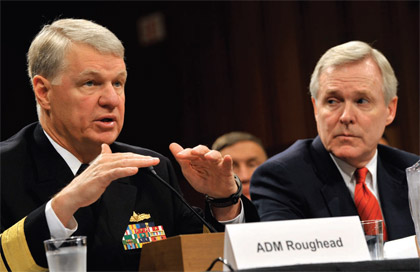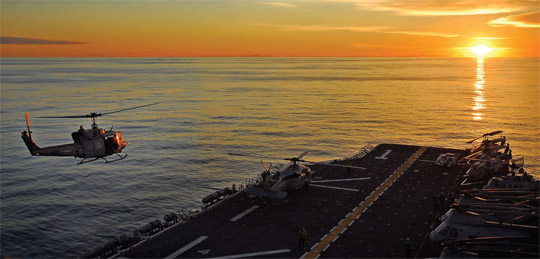Leading America’s Next Great Transformation
The current economic storm has most organizations “hunkering down” for safety and security until weather patterns become more favorable. With few exceptions, companies seemingly serious about sustainable business practices and about transforming corporate cultures are, once again, back to “business as usual.” Many would argue that this mindset caused the economic meltdown in the first place, which would make such a backslide even more problematic. Those companies putting their sustainability commitments and investments on the back burner have clearly signaled that economic considerations come first. At the same time, leaders like Wal-Mart have clearly signaled that the way to increased profitability and operational capability is through sustainability, regardless of the state of the economy. For Rear Admiral Philip Cullom, Director of the U.S. Navy’s Task Force Energy, “It’s all about the ‘art of the long view.’”
With wisdom not unlike Sun Tzu’s Art of War, Cullom explains that the farther out one goes, the “less clear and crisp the future necessarily is. But if you don’t have some ability to vision what that future will be like, then you won’t be able to make good choices today so that we’re properly prepared for tomorrow. At the end of the day, it’s also about whether leadership is focused on this and committed to change, and whether they have the long-range vision.” Clearly, Secretary of the Navy (SECNAV) Ray Mabus, Chief Naval Officer (CNO) Admiral Gary Roughead and Commandant of the Marine Corps (CMC) General James Conway do. The Dept. of the Navy (DON) understands that operational capability depends upon environmental sustainability, which is inextricably linked to energy security and efficient resource use. According to Conway, “We get it.” As a result, the DON is stepping up to take the lead in what is sure to become America’s next great transformation.
“Getting It”
“The United States consumes 25 percent of the world’s oil,” explains Mabus, “but controls production of only 3 percent. To a certain extent, we have ceded a strategic resource – one that is difficult to guarantee – to other nations. This creates an obvious vulnerability to ourenergy security and to our national security and to our future on this planet. The stakes of the status quo extend even further beyond the military and cause second– and third-order effects on our environment.
The carbon that’s emitted from our ships, aircraft and vehicles is a contributor to global warming and to climate change. In short, we have not acted as very responsible stewards of our environment.” The SECNAV believes “the Navy and the Marine Corps have an obligation to do something now” about their impact on the environment – to enact changes that will reduce their energy footprint while simultaneously improving their core warfighting efforts. He continues: “The Department of Defense uses more than 90 percent of all energy used by the Federal government and 2 percent of all energy used in the United States of America. Altering the DON’s consumption patterns will have a broad, noticeable effect and will serve as an example for the rest of our country.”

U.S.N. photo by Mass Comm. Spec.1st Class Tiffini Jones Vanderwyft
Roughead shares this mindset and notes that “we can’t deny the link between oil and climate change and the disasters that can be imposed globally because of that. Our reasons to change our investments and our culture go beyond the threats of the risks; they also go to the opportunities. It’s important that we really institutionally focus on energy security and then the savings of money and resources and, clearly, environmental stewardship. We have to be able, in the energy security area, to find a better way through conservation, technology and alternative sources. It’s important that we seek out those opportunities ahead of us.”
Moving to a Better Future
As head of the finest expeditionary force in the world, Conway adds a unique perspective: “We pride ourselves on being very, very expeditionary – fast, austere and lethal. But we have to contribute to that mindset the thought process of self-sustainment. Once we get to where we’re going, we have to realize that we should not have to be dependent upon a supply line coming from Lord knows where to do what we have to do. There will be other Afghanistans. And the nature of an ungoverned space is just that – it’s where people don’t normally live. It’s where nobody else wants to go. So we have to have the ability to go there and function and do what has to be done but also to be able to supply ourselves with sufficient energy and a much more efficient way of doing things than we are today.”
“‘Getting it’ is about taking the inextricable trends, coupled with uncertainties that can change the dynamics of those inextricable trends, putting it all together and then laying out a future,” explains Cullom. “Those inextricable trends will focus us in some ways. We have to see things moving us toward a better future – one that has less carbon, one that conserves a lot more and one that is more efficient.”
Bold Goals and Targets
In an October 2009 Kennedyesque speech at a Washington, D.C., DON Energy Forum, Mabus encouraged everyone “to dream what might be instead of simply accepting what is” as he committed the Navy and Marine Corps to bold and ambitious energy goals. He reminded everyone that “bold steps are in our nature as Americans” and that “no one has ever gotten anything big done by being timid.” The SECNAV’s 5 new, revolutionary energy targets are as follows:
- 1. Changing the way the Navy and Marine Corps award contracts. The lifetime energy cost and the fully burdened fuel cost of the program or system will be a mandatory evaluation factor. Industry will be held contractually accountable for meeting energy targets and system efficiency requirements. Plus, the overall energy efficiency and the energy footprint of a competing company will be used as an additional factor in acquisition decisions.
- Creating a “green” Strike Group. The Navy will demonstrate in local operations by 2012 a “green” Strike Group, composed of nuclear vessels and ships powered by biofuel. By 2016 the Strike Group will sail as a “Green Fleet,” composed of nuclear ships, surface combatants equipped with hybrid electric alternative power systems running biofuel and aircraft flying only biofuels. And, it will be deployed.
- Reducing DON commercial vehicle fleet petroleum use by half. By 2015 petroleum use in the DON’s commercial fleet of 50,000 vehicles will be reduced by 50 percent. Retired vehicles will be replaced with a new composite fleet of flex-fuel vehicles, hybrid electric vehicles and neighborhood electric vehicles. Mabus believes that “moving to biofuels and electric vehicles will benefit the local communities where our bases are located and will spur adoption of similar vehicles in those neighborhoods.”
- Producing at least one-half of shore-based installation energy requirements from alternative sources by 2020. “We will boost our uses of renewable energy and, in some cases, we’re going to supply energy to the grid from solar, wind, ocean or geothermal sources generated by the base,” says Mabus.
- Providing one-half of the DON’s total energy consumption for ships, aircraft, tanks, vehicles and shore installations from alternative sources by 2020. According to Mabus, 17 percent of the DON’s current energy consumption comes from alternative sources.
Chokepoints and Competition
“Energy powers our way of life, and energy from nonrenewable resources is what we rely on today. We should not delude ourselves into believing that access to those energy sources – primarily oil and gas – is guaranteed for the future. As we all know, they are limited; and we may not know the when, but we know at some point that they are going to be depleted. We can’t predict with certainty how or when scarcity or abundance will affect the global system, and that alone affects our stability and our security as a nation,” explains Roughead.

U.S.N. photo by Mass Comm. Spec. 1st Class Chad J. McNeeleyt
According to the CNO, regardless of availability, those energy sources are uncertain because of potential conflicts and world disorder. Movement of that energy on the “maritime commons” is a critical consideration because the “chokepoints where much of that energy passes can be push buttons for disorder in the future.” And it’s not just about those chokepoints, explains Roughead; it’s also about future resource competition. “The competition, as countries fuel and feed their people and their industry and their growth, is going to continue to take place in the traditional areas where we have been extracting resources. But also, I believe, you’re going to see competition that will begin to take place in the South China Sea, in areas of Africa and, as we move up into the northern regions, in the Arctic.”
Task Force Energy
In December 2008 CNO Roughead charted Task Force Energy (TFE) after seeing his fuel bill go from $1.2 billion to about $5.1 billion in one year. TFE Director Cullom “knew we needed this to be a total team effort with the entire Navy . . . because energy touches all of our lives no matter what part of the Navy responsibilities we may each have. TFE is about combat capability. Where efficiency meets combat capability, it allows us to expand or to extend our tactical reach. And this is absolutely about saving lives as well. Whether that Sailor or Marine is on the ground, on a ship or in the air, we all have a ‘fuel tether’ that dictates our operational capability.”
As a man who’s passionate about making the world a better place, Cullom believes that if the changes the military makes can serve as examples for others, the combined effort could fundamentally change the entire nation’s energy reliance and further reduce the potential for conflict. In addition, the TFE Director believes “there are going to be a lot of changes as a result of people realizing the need to value energy in all of its forms. That’s why carbon is such an important part of this. We have to understand the interconnectedness of the strategic value of energy. As we shift to alternative sources, as we conserve and go for different efficiencies, we also reduce our carbon footprint.”
Cullom believes this is also about a fundamental cultural shift to thinking and working green. “Through greater discussion will come greater understanding, and through a greater understanding will come a change in behavior and innovative thought. The next great effort has to be a ‘regeneration,’ which is exactly what much of this effort is about. The Navy can be an early adopter in a way that really does help lead the nation,” says the TFE Director. And what does the Navy get out of this? According to Cullom, “We’ll get everything we want – from assuring mobility, expanding tactical reach and lightening the load to protecting critical infrastructure and greening our footprint.”
A Greener Footprint
“You may not have seen it or read about it; but on the shore side of the Navy, we’ve never been without a goal that we’ve been chasing for energy reduction during my entire 30-year career,” says Rear Admiral Wayne “Greg” Shear, Commander, Naval Facilities Engineering Command (NAVFAC). “Clearly, there’s every good reason to increase efficiency and to adopt a greener footprint. One, typically there’s always been an Executive Order. And two, the cost savings are very substantial; and that money can be used elsewhere in the Navy, which is why we’ve been working this very hard.
“Something we’re really excited about now is wave energy, which we’re researching with the Office of Naval Research and the Navy Research Laboratory. We’re also interested in ocean thermal energy conversion, which is sending pipes deep below the ocean surface to take advantage of the different temperature strata to generate energy. We’re using wind energy from turbines, but we’re also investigating energy from tidal changes and rivers – putting turbines under water, which then spins energy under water. We’re looking at very common technology – the photovoltaic (PV) – but using it in exciting new ways; and every new building in the Navy is now LEED Silver or better. It increases costs marginally, but the life-cycle and total ownership costs are reduced. I’m very proud of what we do. Frankly, it’s the right thing to do. And if we can save money and reduce carbon, we get a ‘two for one’ so you can’t argue with that,” explains the Engineering Chief.
NAVFAC has always been a visionary organization on the forefront of new technology. Thanks to its championing a little-known energy form – geothermal – back in the 1970s and ‘80s, China Lake became “net zero” before the phrase was even coined. Not only does the naval base produce 20 times more energy than it consumes, it also produces revenue as a result of selling the excess energy back to utility companies.
“Every dollar we save heating or cooling, lighting a building more efficiently or powering our vehicles better is a dollar we can use to keep our guys forward and operating – completing the mission. As a result, we have an implicit Commander’s intent to be as efficient as we can on shore. For 30 years the Navy has always paid attention to this in the context of our shore establishments. But now it’s become much bigger,” comments Shear.
Saving Lives and Limbs
The Marines are equally as ambitious and committed in their sustainable transformation. “We want to reduce our energy consumption by 30 percent by 2015. In terms of our water consumption, we want to reduce that by 16 percent by 2015, and we want to increase our renewable electric power by 25 percent by 2025. Our objective is ‘net zero’ – for our bases and stations to provide as much energy as they make use of. The bottom line is ‘we get it.’ That’s our good news story, and we give ourselves a ‘B’ or ‘B+’ in that particular arena. That said, we’re not doing so well with regard to our expeditionary capabilities. The problem, I think, is a matter of consumption plus inefficiency equals waste,” explains the Commandant of the Marine Corps.

U.S. Navy photo by Journalist 1st Class James G. Pinsky
According to Conway, the 2nd Marine Expeditionary Brigade in Afghanistan uses more than 88,000 gallons of fuel per day with an astonishing fully burdened cost per gallon, in a worst case scenario, of $400. Although the price per gallon is $1.04 to $1.05, it has to be transported via a “very tenuous supply line across Pakistan, where we’re paying large amounts of money to tribes so they don’t fight each other and raid our supply lines – not to mention the security cost, the overhead, the air cover and those types of things for our own convoys. Today 80 percent of our casualties in Afghanistan come from IEDs (Improvised Explosive Devices), and about 10 percent of those come from our resupply convoys. So it’s not just about expense; it’s not just about consumption. At some point we’re talking lives and limbs here in terms of what these inefficiencies are creating. And that, therefore, gives us great motivation to simply get better.”
Potable water is a similar problem. Although it’s available intheatre, “water trucks are carrying 60-ounce plastic bottles traversing bridges and rivers getting to their destination. If you have a mental picture of that, it should cause you a problem. It does me as I look at how we get more efficient with our water supply,” comments Conway. The Marines want to drill, purify, test and approve their water in-theatre. “And we’d like to do that on station and not see any more 40-foot trailers carrying cases and cases of water from places unknown so that we can distribute these plastic bottles everyplace we go. It’s estimated by our assessment team that we can take 50 trucks per week off the roads by doing this. Think back again to what that means in terms of exposure to IEDs, being blown up and, in some cases, being maimed or killed,” explains the CMC.
Thanks to the newly formed Marine Energy Assessment Team (MEAT), as well as to an aggressive pursuit of new ideas, new resource efficient technologies and new partnerships, these and other problems are being transformed into opportunities to save lives and limbs while increasing the Marines’ expeditionary capability.
Environmental Stewardship
“Meeting our energy needs and our environmental goals cannot be two separate areas of concern. They have to be pursued together,” explains Major General E. Gray Payne, ADC I&L (Facilities), Headquarters Marine Corps. “Protection of our natural resources and of our air and water is an absolute top priority for the Marine Corps. It’s not only the right thing to do for our nation and for the communities surrounding our bases and stations, it’s also the right thing to do for the Marine Corps. It’s the only way we can maintain the quality of life that we want for our Marines, our Sailors and their families.”
Aside from visionary alternative energy programs, the USMC is underway with a number of green initiatives at their bases and stations. Some are the more obvious, such as a greater emphasis on recycling because, as Payne explains, “like it or not, we’re in the landfill business.” Some are more aggressive, such as the elimination of plastic bags at three Marine Corps Exchanges, with efforts under way to eliminate them in the remainder as well as in some commissaries. Coupled with this is a significant reduction in the use of Styrofoam, which also has a negative landfill impact.
“We need to continue leading forward with our efforts on bases and stations and operating forces, but we must also be mindful of unintended consequences. Mutual solutions must consider tradeoffs, which balance short-term benefits against long-term sustainability. We can’t go after energy conservation solutions that depend to a great extent, either in the manufacturing or in the maintenance, on water because that’s becoming a scarce resource. Nor can we go after solutions that rely on scarce and declining minerals. We also have to be mindful of invasive species as well as the protection of threatened and endangered species on our bases and stations. We cannot take two steps forward only to find ourselves taking one back. More importantly, we can’t take one step forward to find ourselves taking two steps back,” comments Payne.
World Security
Environmental protection, energy security, resource exploitation and competition, and climate change have grave national and world security implications. According to Vice Admiral Sam Locklear, Director of Navy Staff, the U.S. Navy is uniquely positioned to assist with these burgeoning challenges given its mobility and flexibility of how and where it’s deployed. One of the problems is that, relative to potential global requirement and the probable increased need for worldwide humanitarian assistance, the U.S. Navy requires additional capacity. Currently at only about 285 ships, Locklear states that “at a minimum, the Navy needs 313 ships.”
The Navy currently responds to specific tsunami, hurricane and other relief on a limited scale. But, according to Locklear, they could never do so on a massive scale. “What we can do through our response is to teach people how to respond themselves. We can empower them through training,” explains the Director of Navy Staff. Pertaining to diminished or scarce water resources, he also thinks the American government and Navy could respond with new technologies – processes like reverse osmosis and/or desalination plants. And he thinks the Navy could assist with teaching nations how to manage these plants as national security assets.
“Our core responsibility is to protect this country. But we are learning how to use our forces in a dual-purpose way that allows us to expand our reach and influence in a good way for the future of society. Maybe it’s a little idealistic, but that’s OK. There’s nothing wrong with being idealistic. It’s a good thing to be able to go and help people. Will we do more of this? Yes. As a nation we have a responsibility to do these things. If you’re a world leader, you have to lead in all directions, and I think this is part of the United States Navy because we are forward and, because in many cases, we are a strategic force. We have access to billions of people around the world, and we will take more and more advantage of that access where we can with the resources that the American people give us,” explains Locklear.
Task Force Climate Change
In May 2009 CNO Roughead established Task Force Climate Change (TFCC) to address the impact of climate change on the Navy with an initial Arctic focus. According to Locklear, they’re looking for places where the Navy can best help and best invest to gain a better understanding of the science. TFCC Director and Navy Oceanographer Rear Admiral Dave Titley says, “We need to better understand the science of climate change in order to answer questions about extremes. Are droughts going to be drier? Are floods going to be wetter? Are high temperatures going to be hotter and low temperatures colder? Are there going to be more hurricanes? I just don’t know, which is why it’s critical to put forth a very credible scientific effort.”

U.S.N. photo by Mass Comm. Spec. 3rd Class Daniel A. Barker
One particularly worrisome problem for the Navy’s Oceanographer is ocean acidification, which is caused as CO2 is deposited into the atmosphere and then dissolved by the oceans. According to Titley, “It’s not going to take a lot of acidification to start to potentially, and very significantly, disrupt the base of the food chain. If you take out the zooplankton and the phytoplankton that the critters eat, the scenario that keeps me up at night is what happens if we wake up in 50 years to find out that we don’t have protein for 1-2 billion people? What does that trigger?”
Another concern for Titley is sea level rise. He explains that “nobody is looking for perfect knowledge, but there are very big gaps in the science right now. An 8-inch rise in sea level by 2100 in Norfolk really doesn’t have much of an impact, but a 3-to 3 1/2-foot rise is something that we’d have to take a very hard look at to understand the impacts. A lot of people don’t think 3 1/2 feet of sea level rise is a big deal, but ask anybody on the Mississippi or Gulf Coast. How much of the Outer Banks will still exist? Ask the people in Bangladesh what a meter in sea level rise will mean to them. That’s a very, very big change. It’s hard for people to understand right now, but these will become significant issues.”
The Road Ahead
“Climate change, energy security and national security are inextricably linked. They can’t be considered in isolation; they need to be looked at in a very comprehensive way. We can no longer be content to argue back and forth about what exactly is climate change. Is it real, and is there anything we can do about it? We need to get beyond that. These are challenges to national security, and the military has a role to play not simply in their traditional service roles but also by providing a leadership role for the entire country. When folks sitting on the fence, unsure what to think, understand that the U.S. military is actually doing something about climate change and energy security, it has to give them pause to rethink their own positions and what we, as a nation, should be doing,” explains Vice Admiral (Ret.) Dennis McGinn, CNA Senior Fellow, Military Advisory Board.
McGinn continues: “Across the country, most people are ‘getting it’ when it comes to energy security. However, not everyone is ‘getting it’ when it comes to climate change. Things like Hurricane Katrina can give people a sense of the climate problem. More Katrinas happening more intensely and more frequently throughout the world, but especially in the United States along our East and Gulf Coasts, would have tremendously adverse impacts on human security, health and the economy – not just for weeks or months – but for years. That starts to make climate change real for most people and would encourage them to learn and to do more about it.”
“The average American has a real stake in climate and in the security of this country. Therefore, Americans have a big stake in where we go as a country on energy,” explains Mabus. And at the end of the day, it’s about leading by example and transforming America toward a safer, healthier and more prosperous future for everyone.
“I would very much like to see the DON viewed as an organization that ‘gets it,’ that’s not afraid of change and that’s driving that change. But I believe that, in order to be perceived as such, we have to do something and not simply put a bumper sticker on the back of our cars and drive around. So, to me, it’s all about action; but we have led in other areas, and we can do it again. And, that’s where I want to be,” explains CNO Roughead.





























